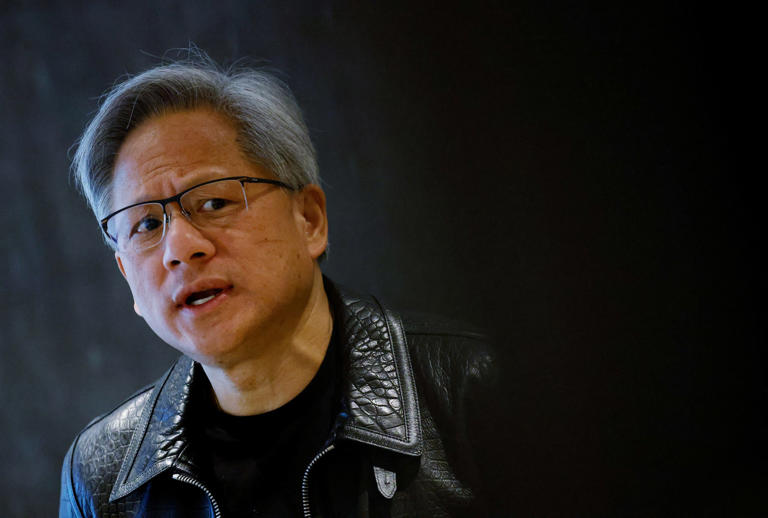
© EDGAR SU / Reuters
Key Takeaways:
- Nvidia has dominated the generative-AI era.
- Competitors like Google, Intel, and Qualcomm are reportedly joining forces.
- They aim to develop a rival technology to challenge Nvidia’s dominance.
- This collaboration signals a potential shift in the competitive landscape of the AI industry.
- It reflects the growing importance of AI technologies and the race among tech giants to innovate in this field.
No company is invincible, but Nvidia has undeniably made a compelling case for its dominance in the tech world. Led by its billionaire CEO, Jensen Huang, Nvidia has captured widespread attention and admiration, as demonstrated by his recent address to a stadium filled with celebrities and developers in San Jose, California. Remarkably, Nvidia has managed to add almost $2 trillion in value in less than 15 months, a feat that few companies can match. Moreover, its latest innovation, the Blackwell chip designed for artificial intelligence applications, has garnered significant interest from prominent figures like Mark Zuckerberg and Sam Altman.
However, beyond its impressive financial performance and groundbreaking technologies, what truly sets Nvidia apart is its software ecosystem, particularly CUDA. Launched in the 2000s, CUDA has cultivated a global community of 4 million developers who rely on it, contribute to its development, and swear by its effectiveness. This software is the linchpin that drives Nvidia’s chips, known as GPUs, and fuels their success among users across various industries.
Yet, Nvidia’s near-invincibility may face challenges in the near future. Rivals in the tech industry have finally mustered the resources and determination to challenge Nvidia’s dominance, particularly in the realm of generative-AI technology. As competitors set their sights on Nvidia’s secret sauce, the future of CUDA and the company’s continued success hang in the balance.
Overcoming a huge moat
CUDA has arguably erected one of Silicon Valley’s most formidable moats, signifying a significant competitive advantage for Nvidia. This moat owes its existence to CUDA’s plug-and-play functionality, which seamlessly connects GPUs to a diverse array of AI applications, regardless of their complexity. The versatility and accessibility offered by CUDA have solidified Nvidia’s position as a leader in the AI industry.
However, competitors have taken notice of Nvidia’s success and are actively working to disrupt its stronghold. A consortium comprising tech giants like Qualcomm, Google, and Intel, known as the UXL Foundation, has quietly assembled with the goal of developing an alternative software suite capable of powering various types of AI accelerator chips. This initiative aims to challenge Nvidia’s moat by offering a more universal solution that transcends specific hardware constraints.
According to reports from Reuters, the UXL Foundation’s software, initially built using Intel technology, is an open-source project designed to enable computer code to run on any machine, irrespective of the underlying chip and hardware. This development is significant for several reasons.
Firstly, major players like Google have been investing heavily in the development of in-house GPUs capable of rivaling Nvidia’s offerings. By harnessing AI capabilities through proprietary hardware, companies like Google are positioning themselves to establish a strong foothold in this crucial sector of the technology industry. This strategic shift underscores the growing importance of AI and the intense competition among tech giants vying for dominance in this field.
A way forward
The significance of software like CUDA cannot be understated in the GPU market, as it plays a pivotal role in influencing buyers’ decisions. CUDA’s widespread adoption among developers, coupled with its user-friendly interface for running AI applications on Nvidia hardware, has entrenched the company’s position as a market leader.
For Nvidia’s rivals, developing their version of CUDA software represents a bold move aimed at enticing developers to consider alternatives to Nvidia’s GPUs. This strategy hinges on the assumption that developers will be willing to explore other chip options, especially amidst ongoing supply constraints affecting Nvidia and other players in the industry.
Vinesh Sukumar, Qualcomm’s head of AI and machine learning, emphasized the consortium’s focus on showcasing viable alternatives to Nvidia’s platform, thereby encouraging developers to transition away from reliance on Nvidia hardware.
Despite these ambitions, it’s important to recognize that the consortium’s technology is still in its nascent stages and is not expected to reach maturity until later in the year. Technical details and implementation specifics are still being refined, highlighting the ongoing development efforts required to bring the alternative software to fruition.
It’s worth noting that Nvidia’s main competitor, AMD, also offers its own competing software solution named ROCm. As the competition intensifies in the GPU market, the emergence of alternative software platforms could potentially reshape the dynamics of the industry, offering buyers more options and potentially challenging Nvidia’s dominance.